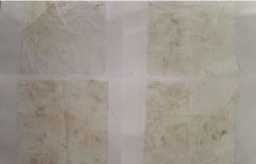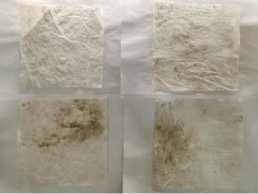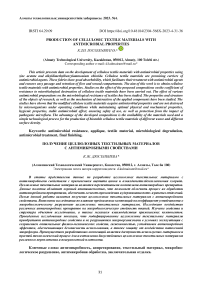Production of cellulosic textile materials with antimicrobial properties
Автор: Dyussenbiyeva K.Zh.
Журнал: Вестник Алматинского технологического университета @vestnik-atu
Рубрика: Технология текстиля и одежды, дизайн
Статья в выпуске: 4 (142), 2023 года.
Бесплатный доступ
This article presents data on the development of cellulose textile materials with antimicrobial properties using zinc acetate and alkyldimethylbenzylammonium chloride. Cellulose textile materials are promising carriers of antimicrobial agents. These fabrics have good absorbability, which facilitates their treatment with antimicrobial agents and ensures easy passage and retention of flow and wound compartments. The aim of this work is to obtain cellulose textile materials with antimicrobial properties. Studies on the effect of the proposed compositions on the coefficient of resistance to microbiological destruction of cellulose textile materials have been carried out. The effect of various antimicrobial preparations on the microbiological resistance of textiles has been studied. The properties and structure of the objects of research, as well as the mechanism of interaction of the applied components have been studied. The studies have shown that the modified cellulose textile materials acquire antimicrobial properties and are not destroyed by microorganisms under operating conditions while maintaining optimal physical and mechanical properties, hygienic properties, stable antimicrobial effect, ensuring safety of use, as well as protection from the impact of pathogenic microflora. The advantage of the developed compositions is the availability of the materials used and a simple technological process for the production of biostable cellulose textile materials of different weave and different surface density.
Antimicrobial resistance, applique, textile material, microbiological degradation, antimicrobial treatment, final finishing
Короткий адрес: https://sciup.org/140303467
IDR: 140303467 | DOI: 10.48184/2304-568X-2023-4-31-36
Текст научной статьи Production of cellulosic textile materials with antimicrobial properties
In recent years, the need to create completely new antibacterial and antifungal fiber materials, as well as products made of them, necessary not only for use in the home, but also for medical applications, has arisen. A healthy body is one of the basic human requirements, but the growth of harmful pathogens has challenged researchers to create antimicrobial textile materials. However, textiles serve not only as a substrate for the growth of microorganisms, but can also be an active carrier of microbes. Infection of textile materials results from the adhesion of microorganisms on the surface, and it is one of the vital clinical complications that causes a high mortality rate. The challenge of finding new ways to protect materials, including by treating them with biocides, is important. Treatment of materials with antimicrobial agents will make it possible to create materials with preplanned antimicrobial properties. In this regard, the work on protection of textile materials from the action of microorganisms is very relevant [1,2].
The main areas of application of antimicrobial textile material can be driven by consumer requirements of health, comfort, easy care and washability. At the same time, giving textile materials made of natural fibers resistance to bio-damage increases the service life of textile products, which allows for additional economic effects. Such multiple properties can be achieved by developing innovative techniques using various finishing agents.
Antimicrobial activity is one of the most important functional properties of cellulose fibers, since these fibers are very easily attacked by both bacteria and fungi [3]. Excessive microbial growth on fibers can cause health and hygiene problems for the textile owner, on the one hand, and reduce the value of the textile product in use, on the other hand. Antimicrobial treatment of textile materials should ensure the resistance of this type of finish to washing, dry cleaning, not to reduce the physical and mechanical properties of the fabric and softness of the grip, as well as be environmentally safe [4,5].
Biodegradation of textile materials caused by microorganisms and their products is expressed in the appearance of stains of different colors depending on the color of the pigment produced by fungi, as well as the appearance of musty odor. Strength properties are changed, there is a loss of mechanical strength, loss of mass and disruption of bonds in fibrous materials [6].
Natural fibers are the easiest target for microbial attack because of their ability to retain moisture. In general, most cellulose and protein fibers are attacked by microbes whose enzymes are capable of hydrolyzing the polymer bonds in fiber materials. Cotton, wool, silk, jute, and linen are the most susceptible to microbial attack. Microbial growth on synthetic fibers is slower compared to their natural counterparts because the polymeric backbone does not retain much water [7,8,9].
However, a greater risk in the manufacture of antimicrobial cellulose fibers is that the inclusion of an antimicrobial agent can destroy the fiber's biodegradability, which is an important characteristic and a significant advantage of cellulose fibers from an environmental perspective [10,11]. Namely, cellulose fibers are known as environmentally friendly fibers because they are easily degraded by soil microorganisms [12,13].
Therefore, creating antimicrobial activity while maintaining fiber biodegradability remains an important task that requires careful selection of an antimicrobial agent and its concentration. The use of antimicrobials to prevent the formation of odorcausing compounds by inhibiting bacterial growth will serve as a solution to this problem [14,15].
Мaterials and research methods
Before the experimental work, the bleached, uncoated cotton fabric was washed in distilled water. After drying, the fabric was kept in a desiccator to determine the exact sample weight. The fabric was processed as follows, according to the two formulations:
Preparation of the composition according to 1 recipe: rockal 20 % 5-15 g/l;
Preparation of the composition according to 2 recipes: zinc acetate 5-15 g/l, urotropin 10 g/l, ammonia 10 % 5 g/l. A sample of cotton fabric with a size of 200 × 200 mm after determining the exact mass on the analytical balances was impregnated with the composition on a laboratory two-shaft plus with 90% pressing, and drying and heat treatment was carried out on needle frames in a drying cabinet with a thermostat. After drying and heat treatment, the sample was washed in distilled water and dried at room temperature.
Results and their discussion
Determination of antimicrobial activity of samples treated with the proposed compositions was carried out in accordance with GOST 9.06075. The results are presented in tables 1,2 and figure 1,2.
Table 1 - Coefficient of resistance to microbiological destruction of modified cotton materials (10 days, 1-recipe)
|
№ |
Concentration Rockal 20%, g/l |
Breaking load (before and after biodestruction), kgf |
|||
|
10 days |
|||||
|
base |
% |
Weft |
% |
||
|
1 |
5 |
11,986/10,004 |
83,46 |
15,596/10,581 |
67,84 |
|
2 |
10 |
12,979/9,853 |
75,91 |
15,640/11,937 |
76,32 |
|
3 |
15 |
13,566/11,743 |
86,56 |
13,075/10,699 |
81,82 |
|
raw material |
10,475/7,153 |
68,28 |
10,083/6,556 |
65,02 |
|
Figure 1 - Cotton fabric processed according to technology 1, after 10 days of microbiological destruction
Table 2 - Coefficient of resistance to microbiological destruction of modified cotton materials (10 days, 2-recipe)
|
№ |
Concentration |
Breaking load (before and after biodestruction), kgf |
|||||
|
Zinc acetate g/l |
Urotropin, g/ l |
Ammonia 10% g/l |
10 days |
||||
|
base |
% |
weft |
% |
||||
|
1 |
5 |
10 |
5 |
15,132/12,311 |
80,35 |
17,447/12,654 |
72,52 |
|
2 |
10 |
14,391/13,261 |
92,14 |
15,120/12,897 |
85,29 |
||
|
3 |
15 |
14,409/13,292 |
92,24 |
17,184/13,961 |
81,24 |
||
|
raw material |
10,475/7,153 |
68,28 |
10,083/6,556 |
65,02 |
|||


Figure 2 - Cotton fabric processed according to technology 2, after 10 days of microbiological destruction
The results obtained indicate that the coefficient of resistance to microbiological destruction of tissue samples treated with composition 1 was 86.56% after 10 days of the strips in contact with the ground. After modification with composition 2, the coefficient of resistance to microbiological destruction is 92.24% after 10 days. For control samples, the coefficient of resistance to microbiological destruction is 65.02% after 10 days. Of the proposed compositions, a high result of the antimicrobial effect is observed in the composition 2. The antimicrobial effect of two compositions is achieved at an average concentration of 10 g/l of rockal preparations of 20% and zinc acetate, more than 80%.
According to GOST, a tissue is considered resistant to microbiological destruction if the coefficient is 80+/-5%. To determine the discontinuous characteristics, the RT-250M GOST 3813-72 bursting machine was used. The results are presented in table 3.
Table 3 - Indicators of absolute breaking load of modified samples, kgf
|
№ |
Breaking load, kgf |
Breaking load, kgf |
||||||
|
1-recipe |
1-recipe |
|||||||
|
base |
weft |
base |
weft |
|||||
|
F (kgf) |
L(mm) |
F (kgf) |
L(mm) |
F (kgf) |
L(mm) |
F (kgf) |
L(mm) |
|
|
1 |
11,986 |
43,77 |
15,596 |
53,11 |
15,132 |
49,57 |
17,447 |
57,38 |
|
2 |
12,979 |
46,62 |
15,640 |
51,40 |
14,391 |
42,93 |
15,120 |
51,67 |
|
3 |
13,566 |
51,17 |
13,075 |
48,46 |
14, 409 |
39,75 |
17,184 |
52,04 |
|
4 |
10,475 |
55,34 |
10,083 |
46,40 |
10,475 |
55,34 |
10,083 |
46,40 |
According to the data obtained, it was shown that the breaking load of the treated tissue according to the first technology with a concentration of 15 g/l of the drug Rokal 20% was 13.566 kgf, the load of untreated tissue was 10.475 kgf, there is an increase in breaking characteristics. According to the second developed technology, the breaking characteristics increase significantly, the breaking load of the appretized sample was 15.132
kgf on the basis, on the duck 17.447 kgf with a zinc acetate concentration of 5 g/l, in the untreated base 10.475 kgf, ducks 10.083 kgf.
The determination of the low crumpledness of modified samples was estimated by the total angle of disclosure of folds on the base and duck, carried out in accordance with GOST 19204-73 on the SMT device. The results of the indicators of low crunchability are shown in table 4.
Table 4 - The effect of the concentration of the components of the composition on the indicators of low crumpled cotton fabric
|
№ |
Concentration |
Total angle of disclosure of folds, deg. |
Concentration |
Total angle of disclosure of folds, deg. |
||
|
Rockal 20% |
Zinc acetate g/l |
Urotropin, g/ l |
Ammonia 10% g/l |
|||
|
1 |
5 g/l |
148 |
5 |
10 |
5 |
195 |
|
2 |
10 g/l |
159 |
10 |
209 |
||
|
3 |
15 g/l |
203 |
15 |
221 |
||
|
raw material |
163 |
raw material |
163 |
|||
When applying the proposed composition, the effect of low crumpleability estimated by the sum of the opening angles for the first technology is 203° at an antimicrobial concentration of 15 g/l, at a concentration of 5,10 g/l of 148, 159 °, the result of the untreated sample is 163 °. According to the second technology, the total angle of opening of the folds at the minimum concentration of zinc acetate 5 g/l was 195 °, against 163 ° before tissue processing. From the data obtained, that the tissue is hardly crumpled after treatment with the second impregnating composition, significantly exceeds the indicator of the low crumpledness of untreated tissue. Thus, it can be concluded about the achieved effect of a hardly crumpled finish.
Breathability is an integral characteristic of the porosity of a textile material. The determination of air permeability was carried out in accordance with GOST 12088-77, the results are presented in table 5.
Table 5 – Indicators of air permeability of processed samples by proposed technologies
|
№ |
Concentration |
Breathability, dm3/m2*s |
Concentration |
Breathab ility, dm3/m2*s |
||
|
Rockal 20% |
Zinc acetate g/l |
Urotropin, g/ l |
Ammonia 10% g/l |
|||
|
1 |
5 g/l |
169,2 |
5 |
10 |
5 |
167,7 |
|
2 |
10 g/l |
170,5 |
10 |
172,5 |
||
|
3 |
15 g/l |
168,3 |
15 |
169,1 |
||
|
raw material |
161,9 |
raw material |
161,9 |
|||
According to the results obtained, it was shown that the processing of cellulosic materials according to the developed technologies does not lead to a violation of air and vapor exchange, does not prevent the transport of moisture vapors from the surface of the human skin to the outer surface of the materials, which ensures the maintenance of normal thermoregulation functions of the human body.
The study of the hardness of cotton textile materials was carried out in accordance with GOST 10550-93. The results are presented in table 6.
Table 6 – Hardness indicators of processed samples by proposed technologies
|
№ |
Concentration |
Stiffness G/sN |
Elasticity, Y,% |
Concentration |
Stiffness G/sN |
Elasti -city, Y,% |
||
|
Rockal 20% |
Zinc acetate g/l |
Urotropin, g/ l |
Ammonia 10% g/l |
|||||
|
1 |
5 g/l |
G=0,5243 |
64,1 |
5 |
10 |
5 |
G=0,3871 |
54,7 |
|
2 |
10 g/l |
G=0,5145 |
68,3 |
10 |
G=0,4361 |
55,8 |
||
|
3 |
15 g/l |
G=0,5782 |
69,6 |
15 |
G=0,4998 |
52.9 |
||
|
raw material |
G=0,3136 |
58,9 |
raw material |
G=0,3136 |
58.9 |
|||
According to the data obtained, it can be seen that the processing of cellulosic material leads to some stiffness according to the first and second technologies, the stiffness of the treated material was G = 0.5782, compared with the untreated material G = 0.3136.
Conclusions
New ways of antimicrobial protection and preparations for microbiological resistance of textile materials were developed. A comparative characterization between the two compositions was carried out. All compositions were tested for their ability to impart antimicrobial properties to the treated fabrics. The results obtained show that the coefficient of resistance to microbiological destruction of fabric samples treated with composition 1 - 86.56%, 2 - 92.24%.
The comparative microbiological resistance of cellulose textile materials was evaluated and it was found that microbiological destruction depends on the nature and structure of the material, as well as the conditions under which exposure occurs. The effect of a number of biocides on the biostability and antimicrobial properties of textile materials has been studied. Methods to protect materials from the effects of microorganisms in order to preserve their consumer properties have been developed.
Список литературы Production of cellulosic textile materials with antimicrobial properties
- A. Soleimani-Gorgani, Z. Karami, “The effect of biodegradable organic acids on the improvement of cotton ink-jet printing and antibacterial activity” Fibers Polym., vol. 17, no. 4 (2016): pp. 512–520.
- M. Zanoaga, T. Fulga, “Antimicrobial reagents as functional finishing for textilesintended for biomedical applications. I. Synthetic organic compounds” Chem. J. Mold., vol. 9, no.1 (2014): pp. 14-32.
- S. Shankar, A.A. Oun, J.W. Rhim, “Prepa- ration of antimicrobial hybrid nano-materials using regenerated cellulose and metallic nano-particles” International Journal of Biological Macromolecules, vol. 107, no. A (2018): pp. 17–27.
- N. Mat Zain, A.G.F. Stapley, G. Shama, “Green synthesis of silver and copper nanoparticles using ascorbic acid and chitosan for antimicrobial applications” Carbohydrate Polymers, vol. 112, no. 4 (2014): pp. 195–202.
- A. Valdes, “Recent Trends in Microencap- sulation for Smart and Active Innovative Textile Products” Current Organic Chemistry, vol. 22, no. 12 (2014): pp. 1237–1248.
- L. Windler, M. Height, B. Nowack, “Comparative evaluation of antimicrobials for textile applications” Environment international, vol. 53, no. 3 (2013): pp. 62–73.
- Y. Xue, H. Xiao, Y. Zhang, “Antimicrobial Polymeric Materials with Quaternary Ammonium and Phosphonium Salts” Int. J. Mol. Sci, vol. 16, no. 2 (2015): pp. 3626–3655.
- M. Owczarek, M. Szkopiecka, S. Jagodzi nska, M. Dymel, M. Kudra, K. Gzyra-Jagieła, P. Miros-Kudra, “Biodegradable Nonwoven of an Aliphfatic-Aromatic Copolyester with an Active Cosmetic Layer” Fibres Text. East. Eur. 2019, 27, 102–109.
- Z. Li, J. Chen, W. Cao, D. Wei, A. Zheng, Y. Guan, “Permanent antimicrobial cotton fabrics obtained by surface treatment with modified guanidine” Carbohydr. Polym, vol. 180, no. 2 (2018): pp. 192–199.
- H. Qiu, Z. Si, Y. Luo, P. Feng, X. Wu, W. Hou, Y. Zhu, M.B. Chan-Park, L. Xu, D. Huang, “The Mechanisms and the Applications of Antibacterial Polymers in Surface Modification on Medical Devices” Front. Bioeng. Biotechnol, vol. 8, no. 4 (2020): pp. 910.
- A. N. Seyyed, H. Nahid, A.R. Jorge, “Ligand modified cellulose fabrics as support of zinc oxide nanoparticles for UV protection and antimicrobial activities” Int. J. Biol. Macromol, vol. 154, (2020): pp. 1215-1226
- I.Shahid, B.S Butola, “Recent advances in chitosan polysaccharide and its derivatives in antimicrobial modification of textile materials” Int. J. Biol. Macromol, vol. 121, (2019): pp. 905-912
- A. E. Tarek, E. Hanan, N. Elham, A. Seif, S. Mamdouh, “Novel nano silica assisted synthesis of azo pyrazole for the sustainable dyeing and antimicrobial finishing of cotton fabrics in supercritical carbon dioxide” J Supercrit Fluids, vol. 179, (2022): pp. 156-168
- I.Manikandan, G. Vijaykumar, H. Chunyan, G.S. Nagananda, R. Narendra, “Curcuma longa L. plant residue as a source for natural cellulose fibers with antimicrobial activity” Ind Crops Prod, vol. 112, (2015): pp. 556-560
- R. Aisha, R. Abdur, K. Waleed, S. Faiza, B. Abdul, S.M. Hafiz, I. Kashif, A. Munir, “Simultaneous dyeing and anti-bacterial finishing on 100% cotton fabric: process establishment and characterization” Cellulose, vol. 2, (2018): pp 5405-5414.


